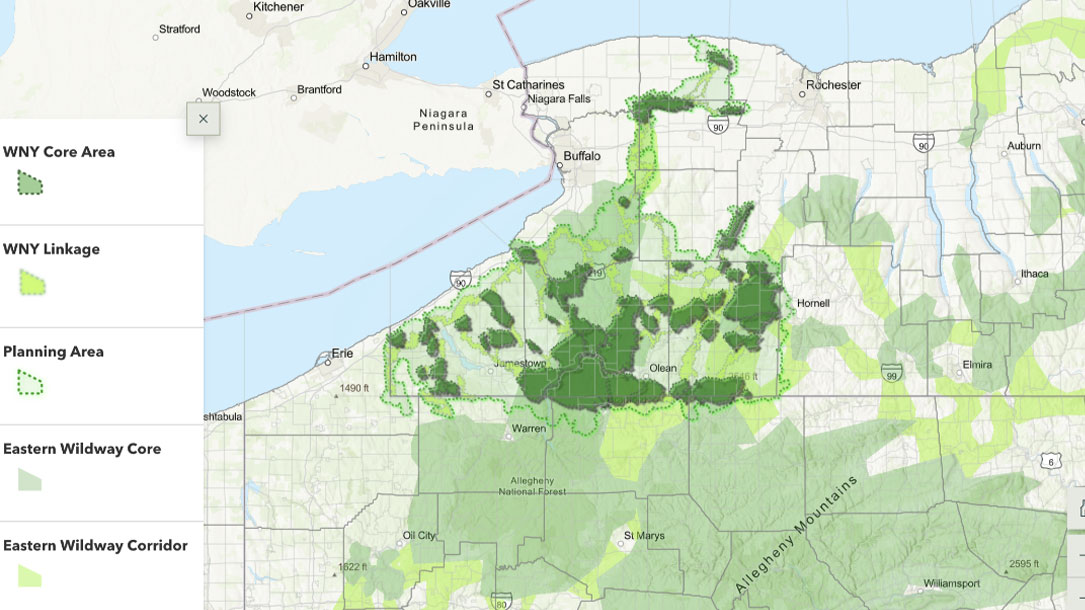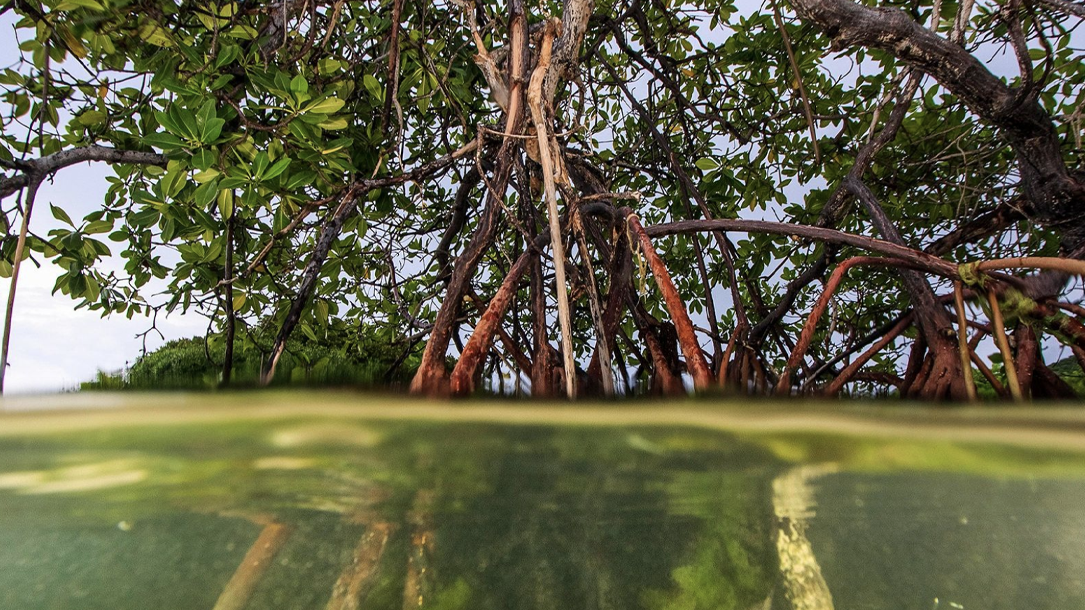Home > Climate News >

A bold initiative
The Western New York Land Conservancy is leading an effort to create the WNY Wildway, an ambitious long-term plan to protect and connect the largest of their region’s remaining forests. The Wildway will connect the vast forests of northern Pennsylvania to the Great lakes, through to the Finger Lakes, the Adirondacks, and beyond. It will form part of the Eastern Wildway which runs all the way from Canada to the Gulf of Mexico.
The Wildway will allow plants and animals to roam across the land as they once did, to move as climate changes, and to expand their ranges and ensure their survival. It will allow wildlife that have disappeared from their region to return home.
You can learn more, and perhaps draw inspiration for your own region, by viewing their “story map” which provides images as well as text to convey the challenges and solutions.

Largest urban forest carbon credit purchase to support conserving land
The largest urban forest carbon credit sale in the nation, as of 2021, will support land conservation in the southwestern Pennsylvania region by Allegheny Land Trust.
This significant purchase increases the capacity of the land trust to conserve and care for more crucial green space in southwestern Pennsylvania…

The science of solar-pollinator habitat: a fact sheet
Land trusts and community groups can help their communities understand how the design, implementation, and management of solar fields can work to enhance biodiversity and pollinators as well as farming and ranching. In this case, a recent fact sheet by the AgriSolar Clearinghouse provides useful information share.

Land trust works with partners to complete forest-thinning project in Angwin
The Land Trust of Napa County, California State Coastal Conservancy, Napa County Resource Conservation District (Napa RCD), and the Natural Resources Conservation Service are pleased to announce completion of a large fuels reduction and forest health project on the Land Trust’s Linda Falls Preserve in Angwin, CA.
This preserve is open to the public and many visitors come to the property to hike and see Linda Falls, a waterfall along Conn Creek.
The project involved thinning the forest across 120 acres. The thinning is aimed at both reducing the risks of wildfire along the southeast flank of the community of Angwin and increasing the resilience of the forest to fires, drought and other effects of climate change.
Angwin is one of the few areas in the hills of Napa County that has not burned in the last five years so wildfire risk reduction there is a priority for CAL FIRE, Napa Communities Firewise, and Napa County Fire…

How satellite-guided cows might save the Kansas prairie and make ranchers more money
STRONG CITY, Kansas — Third-generation rancher Daniel Mushrush has 30-plus miles of barbed wire fence to tend to.
Calves wriggle beneath it. The wires get loose. Wild animals take a toll. And when streams surge after storms, rushing water often snaps sections in two.
For Mushrush and his family, the fence-mending on their Flint Hills ranch never ends. It’s inescapable.

Climate change threatens the Great Plains, but bison may hold a key to resilience
“The 8,600-acre Konza Prairie Biological Station where Kansas State conducts its bison research lies in the Flint Hills, North America’s biggest remaining stretch of tallgrass prairie.
Once one of North America’s major ecosystems — covering large swaths of the Great Plains from what is today central Texas to south-central Canada — settlers and their descendants destroyed more than 95% of the continent’s tallgrass prairie for cropland and other development. Tallgrass in the Flint Hills escaped the plow only because the region’s shallow soil and rocky layers made farming less practicable there…
Bison act and eat differently than cattle do, though biologists say not all the differences are clear yet. Few studies compare these two bovine herbivores side by side.
Still, a few differences jump out. The bigger species not only eats more grass, it also spends less time along streams than cattle do and more time on hilltops…”
Cattle may not boost plant biodiversity on the prairie as much as bison do, but The Nature Conservancy thinks it’s possible to manage them in ways that support healthier grassland.
They are working with a Flint Hills cattle rancher near Strong City in Kansas, along with Kansas State scientists, to see how fitting a herd with GPS collars might help….

Nature-based solutions funding database
National Wildlife Federation has created an interactive database for communities interested in pursuing federal funding and/or technical assistance for nature-based solutions. You can use their filters to search for nature-based solutions funding and technical assistance resources that fit your needs. For additional information on search filters, see their Glossary page.

How nature can get us 37 percent of the way to the Paris Climate Target
“The last two years have seen significant global advancement on climate action, with hundreds of global businesses and national and sub-national leaders building on the momentum of the Paris Agreement to initiate new climate pledges, initiatives and funding programs. But there remains a gap between promised action and realized climate progress, and many solutions available to us now remain underutilized—especially in the land sector, which currently accounts for nearly a quarter of greenhouse gas emissions…”

Sweet return: German farmer gets both solar power and apples
Many of the apple trees growing beneath solar panels have been producing bountiful electricity during this year’s unusually sun-rich summer, while providing the fruit below with much-needed shade.
“The idea is simple,” said Nachtwey, whose farm lies in Gelsdorf, an hour’s drive south of Cologne. “To protect the orchard, without reducing the available growing surface and in particular maintaining production. On top of that there’s the solar electricity being generated on the same land.”
Large-scale solar installations on arable land are becoming increasingly popular in Europe and North America, as farmers seek to make the most of their land and establish a second source of revenue.

Mississippi Valley Conservancy: Climate change
Together, we can make a difference
What is it about the Driftless area you love? Is it the foggy mornings overlooking the valley? Or going fishing with your family in the spring? Perhaps it’s the sounds of migrating sandhill cranes and the call of the spring peepers.
Too often we think of climate change as occurring on a global scale or something that will happen in the future. Yet climate change already is causing profound changes with damaging effects to the land and water you love. Wildlife habitat, lakes and streams, and farmland, right here in the Driftless Area, are at risk as never before.












